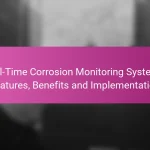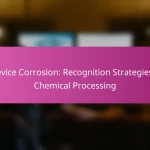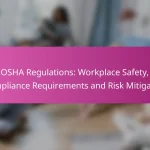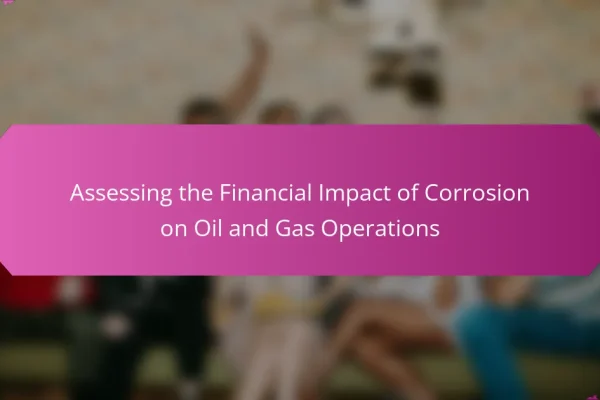How does corrosion impact the manufacturing industry?
Corrosion significantly affects the manufacturing industry by increasing operational costs and reducing efficiency. It leads to various financial burdens, including maintenance, downtime, and the need for material replacements.
Increased maintenance costs
Corrosion necessitates more frequent maintenance of equipment and machinery, which can inflate operational budgets. Regular inspections and repairs are essential to prevent failures, often leading to costs that can rise into the thousands of dollars annually.
Manufacturers should implement a proactive maintenance schedule to mitigate these costs. Utilizing corrosion-resistant materials and protective coatings can also help reduce the frequency of maintenance required.
Production downtime
Corrosion can lead to unexpected equipment failures, resulting in costly production downtime. This interruption not only affects output but can also delay project timelines and impact customer satisfaction.
To minimize downtime, companies should invest in predictive maintenance technologies that can identify corrosion issues before they lead to failures. Regular training for staff on corrosion management can also enhance operational resilience.
Material replacement expenses
When corrosion damages equipment beyond repair, manufacturers face significant material replacement expenses. This can include the cost of new machinery, components, and the labor required for installation.
To manage these expenses, businesses should consider using higher-quality materials that resist corrosion, even if they come at a premium upfront. Additionally, establishing a budget for unexpected replacements can help cushion the financial impact of corrosion-related issues.
What are the economic costs of corrosion in the oil and gas sector?
The economic costs of corrosion in the oil and gas sector can be substantial, impacting both operational efficiency and profitability. These costs arise from various factors, including asset management, environmental compliance, and regulatory obligations.
Asset integrity management costs
Asset integrity management costs refer to the expenses associated with maintaining the safety and functionality of equipment and infrastructure. In the oil and gas sector, these costs can include regular inspections, maintenance, and repairs, which are essential to prevent failures due to corrosion.
Companies often allocate a significant portion of their budgets to corrosion management programs, which can range from tens of thousands to millions of dollars annually, depending on the size of the operation and the extent of corrosion-related issues. Investing in advanced monitoring technologies can help reduce long-term costs by identifying corrosion early.
Environmental remediation expenses
Environmental remediation expenses arise when corrosion leads to leaks or spills, necessitating cleanup efforts. In the oil and gas industry, these costs can be particularly high due to the potential for significant environmental damage and the need for compliance with strict regulations.
Remediation efforts may involve soil and water treatment, disposal of contaminated materials, and restoration of affected areas. Depending on the severity of the incident, these costs can reach hundreds of thousands to millions of dollars, emphasizing the importance of effective corrosion management to mitigate risks.
Regulatory compliance costs
Regulatory compliance costs are incurred when companies must adhere to government regulations regarding corrosion control and environmental protection. In the oil and gas sector, these regulations can be stringent, requiring regular reporting and adherence to safety standards.
Failing to comply can result in hefty fines and legal fees, which can significantly impact a company’s bottom line. It is crucial for organizations to stay informed about relevant regulations and invest in compliance strategies to avoid these potential costs.
How can industries mitigate corrosion-related losses?
Industries can mitigate corrosion-related losses by implementing effective strategies that focus on prevention and maintenance. These strategies include using corrosion-resistant materials, conducting regular maintenance and inspections, and applying protective coatings to extend the lifespan of assets.
Implementing corrosion-resistant materials
Using corrosion-resistant materials is a proactive approach to minimizing losses. Industries should consider materials such as stainless steel, aluminum, or specialized alloys that are designed to withstand corrosive environments.
When selecting materials, it is essential to evaluate the specific conditions they will face, such as exposure to moisture, chemicals, or extreme temperatures. This assessment can help in choosing the most suitable options for various applications.
Regular maintenance and inspections
Regular maintenance and inspections are critical for identifying corrosion early and preventing extensive damage. Establishing a routine schedule for inspections can help detect signs of corrosion before they escalate into costly repairs.
During inspections, focus on high-risk areas such as joints, welds, and surfaces that are frequently exposed to moisture. Implementing a checklist for maintenance tasks can ensure thorough evaluations and timely interventions.
Using protective coatings
Applying protective coatings is an effective method to shield surfaces from corrosion. These coatings can include paints, sealants, or specialized corrosion inhibitors that create a barrier against environmental factors.
When selecting a coating, consider factors such as the type of substrate, environmental exposure, and the expected lifespan of the coating. Regularly reapplying these coatings as part of maintenance can significantly enhance protection and reduce corrosion-related costs.
What role does corrosion play in infrastructure deterioration?
Corrosion significantly contributes to the deterioration of infrastructure by weakening materials and leading to structural failures. This process not only affects the longevity of assets but also poses risks to public safety and incurs substantial economic costs.
Impact on public safety
Corrosion can compromise the integrity of critical infrastructure such as bridges, roads, and pipelines, leading to potential hazards for users. For example, corroded bridges may collapse, while deteriorating pipelines can cause leaks or bursts, resulting in environmental damage and safety risks.
Regular inspections and maintenance are essential to identify corrosion early. Adhering to safety regulations and standards can help mitigate risks and protect public safety effectively.
Repair and replacement costs
The financial burden of corrosion manifests through repair and replacement costs, which can be substantial. For instance, repairing corroded infrastructure may cost tens of thousands to millions of dollars, depending on the extent of damage and the materials involved.
Investing in corrosion-resistant materials and coatings can reduce long-term expenses. Proactive maintenance strategies can also minimize the need for costly repairs and extend the lifespan of infrastructure.
Long-term economic implications
The long-term economic implications of corrosion extend beyond immediate repair costs. Infrastructure failures can disrupt transportation, supply chains, and utilities, leading to lost productivity and economic downturns.
Governments and industries must consider the cumulative costs of corrosion when planning budgets and infrastructure projects. Implementing preventive measures can yield significant savings and enhance overall economic stability.
How does corrosion affect the transportation industry?
Corrosion significantly impacts the transportation industry by increasing maintenance costs and affecting infrastructure reliability. It leads to higher expenses for vehicle upkeep and repairs, as well as costly infrastructure replacements, ultimately disrupting operations.
Increased vehicle maintenance
Corrosion accelerates wear and tear on vehicles, leading to more frequent maintenance and repairs. Components such as brakes, fuel tanks, and exhaust systems are particularly vulnerable, requiring regular inspections and replacements to ensure safety and performance.
For instance, transportation companies may find themselves spending up to 20% more on maintenance due to corrosion-related issues. Implementing preventive measures, such as regular rust-proofing treatments, can help mitigate these costs.
Infrastructure repair costs
The transportation infrastructure, including roads, bridges, and railways, suffers from corrosion, leading to significant repair expenses. Aging structures often require extensive rehabilitation to maintain safety standards, which can strain budgets.
In the United States, it is estimated that billions of dollars are spent annually on repairing corroded infrastructure. Investing in corrosion-resistant materials during construction can reduce long-term repair costs and enhance durability.
Impact on logistics and supply chains
Corrosion can disrupt logistics and supply chains by causing delays in transportation and increasing costs. When vehicles are out of service for repairs, delivery schedules can be affected, leading to potential losses in revenue.
Additionally, corrosion-related infrastructure failures can lead to traffic congestion and increased transit times. Companies should consider regular maintenance schedules and invest in corrosion management strategies to minimize these disruptions.
What are the best practices for corrosion management?
Effective corrosion management involves a combination of preventive measures, regular inspections, and timely maintenance. Implementing best practices can significantly reduce the economic impact of corrosion on industries.
Regular Inspections
Conducting regular inspections is crucial for identifying early signs of corrosion. This can include visual checks, ultrasonic testing, and other non-destructive methods. Inspections should be scheduled based on the environment and the criticality of the equipment.
For example, facilities in coastal areas may require more frequent inspections due to higher humidity and salt exposure. Establishing a routine inspection schedule helps in detecting corrosion before it leads to significant damage or costly repairs.
Protective Coatings
Applying protective coatings is one of the most effective ways to prevent corrosion. These coatings act as a barrier between the metal surface and corrosive elements. Common types include paints, galvanization, and powder coatings.
Choosing the right coating depends on the specific environment and the type of metal being protected. For instance, epoxy coatings are often used in industrial settings due to their durability and resistance to chemicals.
Corrosion Inhibitors
Corrosion inhibitors can be added to fluids or applied directly to surfaces to slow down the corrosion process. These chemicals work by forming a protective film on the metal surface or by neutralizing corrosive agents.
Inhibitors are particularly useful in water systems and can be a cost-effective solution for extending the lifespan of equipment. However, it is essential to select inhibitors that are compatible with the materials and conditions of the system.
Proper Material Selection
Choosing the right materials for construction and manufacturing can greatly reduce corrosion risks. Materials like stainless steel, aluminum, and certain alloys are more resistant to corrosion compared to standard steel.
When selecting materials, consider the operating environment and potential exposure to corrosive substances. Investing in higher-quality materials may lead to lower maintenance costs over time.
Maintenance and Repair
Timely maintenance and repair are vital for managing corrosion effectively. Addressing minor issues promptly can prevent them from escalating into major problems that require extensive repairs or replacements.
Establishing a maintenance plan that includes regular cleaning, touch-ups of protective coatings, and prompt repairs can significantly enhance the longevity of assets. Training staff on corrosion awareness can also help in identifying and addressing issues early.












